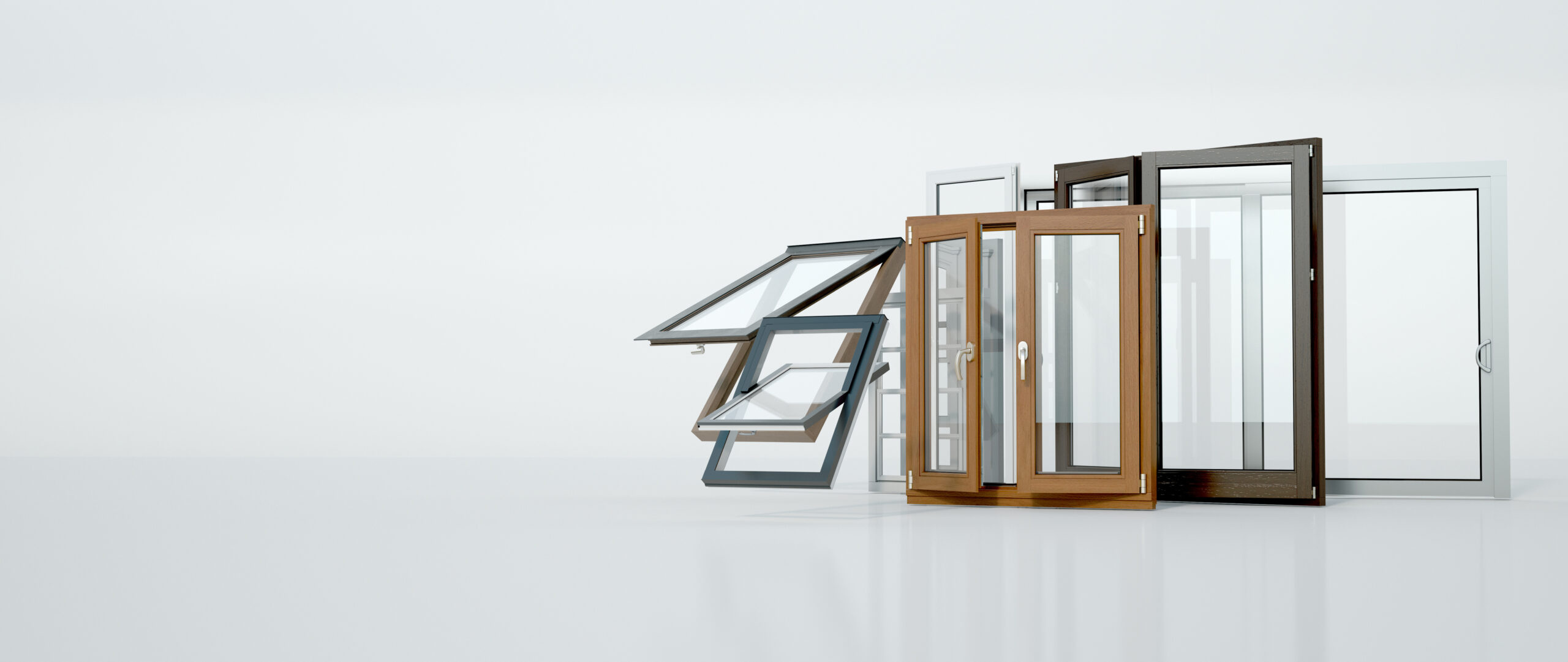So, you need new windows. Simple, right? Simply contact your local double-glazing company and put in your order. After all, windows are just white uPVC and rectangular shaped?
This is not the case. The world of windows has come a long, long way over the years and the days of standard white plastic ones that dominated the suburban landscape since the 1980s are long gone.
Window styles are more customisable than ever and now consist of casements, flush sash, tilt and turn, reversible, bay, bow – the list continues. White uPVC is no longer exclusive – there’s a variety of colours and finishes available, and you can choose from alternative materials such as aluminium and timber.
If you’re feeling overwhelmed, fear not, we’re here to help you navigate this glazing labyrinth – giving details on all the different styles of windows you could choose for your home improvement projects.
Casement windows
Around for centuries, casement windows remain one of the most popular window styles available, originally consisting of a single frame window hinged into a timber or stone aperture.
Functional, durable, and available in a huge range of styles and designs, casement windows can be top, bottom or side hung and are attached to the window frame by one hinge or more.
Different casement window styles include:
- Side Hung – hinged at the side for easy opening, the most recognisable casement
- Top Light – a fixed pane that is divided from a narrow-glazed top-hinged casement
- Top Hung/Awning – hinged at the top to block out the rain, this casement window is ideal for wet climates
- Bottom Hung/Hopper – commonly used in basements or cellars, hinged at the bottom
- Centre Hung/Pivot – requires less swinging clearance, hinged in the centre to allow for a wider opening
Casement windows – pros and cons:
- Manufactured in standard, modular sizes, means they are usually the cheapest style
- Open wide, making them ideal for ventilating rooms, but may cause concern if you have small children or animals –this can be mitigated with the installation of secure window restrictors
Flush sash windows
They say that style never goes out of fashion, and if one style of window combines a truly classic aesthetic with cutting-edge design and functionality, it’s the flush sash window.
Sometimes referred to as flush casement windows, flush sash windows fit plumb into the window frame for a flat exterior when closed, as opposed to casement windows which overlap the window frame slightly.
The sleek design of this style offers the authentic timber style of yesteryear, making them the perfect option for traditional homes, period properties, and even listed buildings. However, the sleek continuous finish of this style also makes them a popular choice for contemporary settings and are increasingly popular in modern developments.
Flush sash windows – pros and cons:
- Classic design with all the benefits of modern manufacturing
- Timeless appearance for traditional properties
- Equal sightlines
- More expensive than casement windows
Tilt and turn windows
With tilt and turn windows, you get the best of both worlds. They allow you to open the window horizontally like a casement window. Still, they can also be tilted inwards, which is a perfect method for providing a secure source of ventilation.
Tilt and turn windows are handy in rooms above the first floor – when opened horizontally, cleaning the outside surface of the window is easy to do from inside your home.
The style and functionality of tilt and turn windows make them an ideal choice for contemporary properties – for additional peace of mind, they’re designed with multi-point locking systems for extra security.
Tilt and turn windows – pros and cons:
- Exceptionally secure
- Space savers – ideal for smaller rooms
- Usually made to order, so more expensive
- Mechanical moving parts will require maintenance
Fully reversible windows
An ideal choice for properties where washing the exterior of a window can be a challenge – think high-rise residential buildings, then fully reversible windows can be turned completely around so that you can clean them whilst remaining safe in your own home.
Unlike other styles that slide or tilt to open, these windows turn 180 degrees on hinges built into the frame, meaning you have unhindered access to both sides of the glass. Because they open outwards, fully reversible windows are popular for use near sinks or other locations where opening might be restricted due to items kept near the windowsill.
Incredibly easy to operate, the mechanism utilises safety catches that need a manual release before the window can fully rotate, ensuring they are safe and secure.
Fully reversible windows – pros and cons:
- Offers optimum ventilation – on hot days, a reversible window can be opened almost entirely for unbeatable airflow
- Doesn’t snag on curtains or blinds
- Safe, secure, and easily cleaned
- Mechanical moving parts will require maintenance
Bay & Bow windows
Often seen in Victorian and Edwardian homes, bay and bow windows stick out from the front of a building to create a cove-like interior space, enabling you to utilise it in various ways, such as a window seat or breakfast nook.
Bay windows usually comprise three main windows, one large one in the centre, parallel to the outside wall, and two matching ones on either side angled out to meet it.
When the face of a building is architecturally curved, a bow window is required. These comprise four or more smaller windows in an arc formation.
Both window styles are an ideal way to create the feeling of space and to benefit from natural daylight.
Bay and bow windows – pros and cons:
- Adds kerb appeal to home exterior
- Creates space inside, increasing value
- Will require custom-made curtains or shutters
Sliding sash windows
For centuries, sash windows were the window style of choice in Britain. Although the construction of more contemporary properties in the 1960s saw casement windows supersede that popularity, the turn of the millennium witnessed a new-found love for the style and functionality of this glazing classic.
This return to grace makes sash windows an ideal choice if you want to capture a traditional aesthetic for your home or if you want to replace an old, tired single-pane sash window with a modern equivalent. This means you can have all the energy efficiency benefits of double glazing without losing the character this style provides.
Sash windows comprise one or more movable sashes that can be opened vertically or even horizontally, in some cases, via a sliding mechanism.
Traditionally made with timber frames, sash windows are now available in uPVC and aluminium versions. You can have elegance and practicality while benefitting from increased thermal efficiency and much less maintenance.
Sliding sash windows – pros and cons:
- Sliding sash windows usually have vertical tracks, so they won’t get clogged up with leaves and other debris
- Extra secure – as only one panel can be opened at a time, they’re much more difficult to climb through than casement windows
- Sash windows provide limited ventilation
- Mechanical moving parts require maintenance
Roof windows
Roof windows are self-explanatory – they’re windows in a roof. Most utilised in loft conversions or on sloping roofs, roof windows, including rooflights, lanterns and skylights, are the perfect way to introduce natural daylight and fresh air to areas of a property which can’t accommodate a standard style of windows.
Different styles include:
- Roof windows – these can be opened outwards or pivot and are integrated into the design of a roof
- Roof lanterns – fitted into the roof to flood the area below with natural daylight, lanterns are available in a wide choice of shapes and configurations and are manufactured in uPVC, aluminium, and timber
- Rooflights – ideal for loft conversions; these are windows fitted into the roof and available in a choice of materials. Lying flush with the roofline or sitting slightly proud of it, some rooflights can be opened manually, while others can be operated by remote control or via a wall panel
- Skylights – these are becoming more and more popular in terraced houses with side return extensions
Roof windows – pros and cons:
- Lightens up dark spaces and areas with poor lighting
- Natural daylight cuts down on the need for electrical lighting and saves on energy bills
- Better internal light can improve property sale potential
- Incorrect installation could lead to uncontrolled heat
- Cleaning can be a task
- Privacy may need to be considered especially in terraced homes
Fixed windows
If you’re looking to maximise the amount of natural daylight in an area of your home, but don’t need the ventilation of a window style that you can open, then a fixed window is an ideal choice. As they don’t need to incorporate an opening mechanism into the manufacturing process, it means that fixed windows are available in a vast range of designs and styles, including picture windows and gable glazing.
Fixed windows – pros and cons:
- Introduce natural light in wasted spaces
- Typically, the style of window that costs the least
- Available in a wide choice of designs
Hopefully, this comprehensive guide to all the different styles of windows will help you make an informed choice when it comes to your home. If you’ve decided or want more advice about window styles, contact your nearest Certified Competent installer, who can discuss your options.


